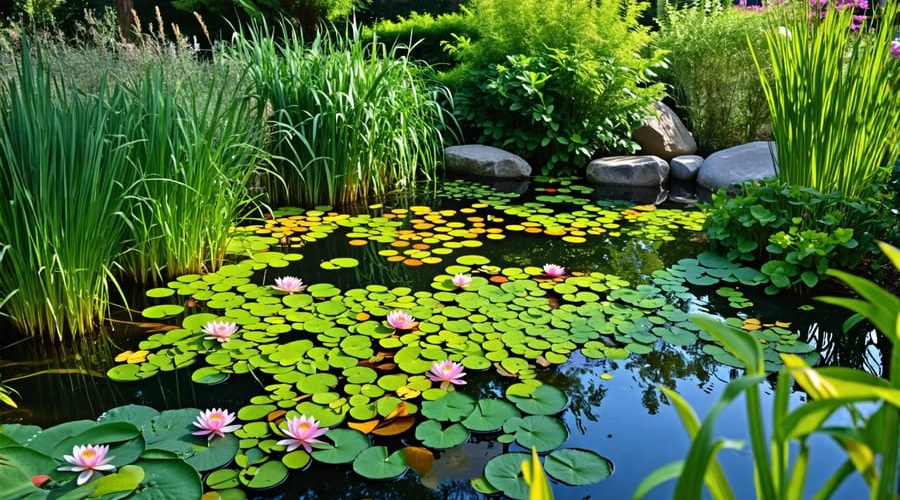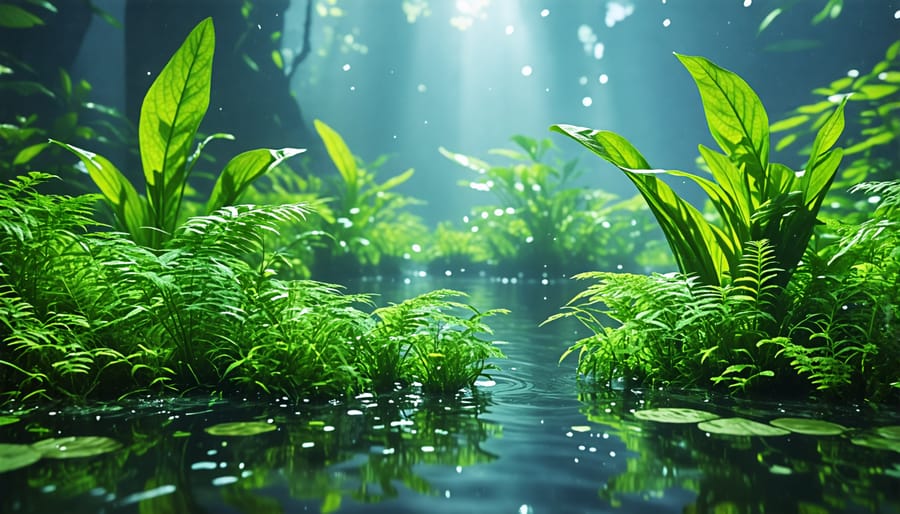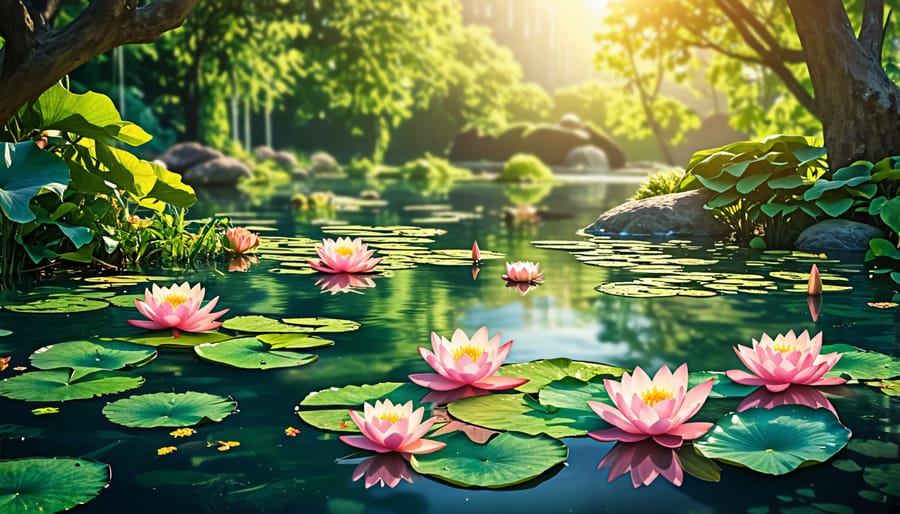
12 Stunning Water Plants to Create Your Dream Pond Paradise
Choose the right aquatic plants to create your dream backyard pond paradise. Select a variety of plant types including floating, submerged, marginal, and bog plants to add visual interest and maintain water health. Consider factors like sunlight, water depth, climate, and pond size when picking backyard pond ideas and plants. Provide proper care for each plant species, such as fertilizing, pruning, and controlling growth as needed to keep your water garden thriving and beautiful season after season.
Floating Plants

1. Water Hyacinth
Water hyacinth is a stunning floating plant that adds a unique charm to any water garden. Its glossy, rounded leaves and vibrant lavender flowers create a captivating display on the water’s surface. This fast-growing aquatic plant is incredibly easy to care for, thriving in full sun to partial shade. Simply allow it to float freely, and it will quickly multiply, forming a lush green carpet.
Water hyacinth is not only beautiful but also beneficial, as it helps absorb excess nutrients and purify the water. However, be cautious as it can spread rapidly in ideal conditions. Regular thinning may be necessary to prevent overcrowding. With its low-maintenance nature and striking appearance, water hyacinth is a must-have for any water garden enthusiast looking to add a touch of elegance and functionality to their pond.
2. Water Lettuce
Water lettuce, with its rosettes of velvety green leaves, adds a whimsical touch to any water garden. This fast-growing floating plant thrives in full sun to partial shade and requires no planting – simply place it on the water’s surface. As it multiplies, water lettuce helps shade the pond, minimizing algae growth. Its dangling roots provide a haven for fish fry and beneficial bacteria. Trim older leaves regularly to maintain its neat appearance. In colder regions, bring some plants indoors for winter and return them to the pond in spring. With its ability to filter water and its charming look, water lettuce is a delightful addition that brings both beauty and balance to your aquatic oasis.
3. Frogbit
Frogbit, or Limnobium laevigatum, is a charming floating aquatic plant that adds a delicate touch to any water garden. Its rounded, light green leaves resemble tiny lily pads, while the roots dangle beneath the surface, creating a haven for fish and beneficial microorganisms. Frogbit thrives in still to slow-moving water and prefers partial shade to full sun exposure. To care for this plant, simply allow it to float freely on the water’s surface and remove any yellowing or dead leaves as needed. Frogbit is an excellent choice for controlling algae growth, as it competes for nutrients and helps shade the water. Its petite size and rapid growth make it perfect for small to medium-sized ponds or container water gardens.
Submerged Plants

4. Hornwort
Hornwort, an underwater marvel, is a must-have for any water garden. This adaptable plant thrives in various conditions, making it perfect for beginners. Its feathery, bright green foliage sways gracefully beneath the surface, providing oxygen and filtration benefits. Hornwort grows quickly, helping to outcompete algae and keep your pond crystal clear. Simply let it float freely or anchor it to the bottom for a lush, submerged garden.
As hornwort doesn’t root, it’s incredibly low-maintenance. It tolerates a wide range of temperatures and light levels, though it prefers cooler water. Alongside filters for water gardens, hornwort acts as a natural water purifier, absorbing excess nutrients. Propagate it easily by snipping off stems and watching them grow. With its versatility and vibrant green hue, hornwort is a fantastic choice for adding texture and depth to your aquatic oasis.
5. Anacharis
Anacharis, also known as Brazilian waterweed or Elodea, is a popular submerged aquatic plant for water gardens. Its lush, green foliage adds a vibrant touch to ponds while providing valuable benefits. Anacharis grows rapidly, helping to oxygenate the water and absorb excess nutrients that can fuel algae growth. Its dense growth offers shelter for fish and aquatic invertebrates. This adaptable plant thrives in a wide range of conditions, tolerating varying light levels and temperatures. Simply anchor anacharis in the substrate or allow it to float freely for a natural look. Prune regularly to control its spread and remove any yellowing leaves. With its easy care and lush appearance, anacharis is a fantastic choice for creating a thriving underwater ecosystem in your water garden.
6. Cabomba
Cabomba, also known as fanwort, is a popular submerged aquatic plant that adds a delicate, lacy texture to water gardens. Its finely dissected, fan-like leaves come in shades of green, red, or purple, creating an ethereal underwater display. Cabomba is a fast-growing plant that provides excellent oxygenation and filtration for ponds, while also serving as a hiding spot for fish and other aquatic life.
To care for cabomba, plant it in a medium to large pond with depths of at least 12 inches. It prefers full sun to partial shade and thrives in temperatures between 72-82°F. Cabomba appreciates regular fertilization and benefits from occasional pruning to control its growth. With its feathery foliage and easy maintenance, cabomba is a must-have for any water garden enthusiast looking to create a captivating submerged landscape.
Marginal Plants
7. Cattails
Cattails, also known as Typha, are a classic addition to any water garden. These tall, slender plants feature long, sword-like leaves and distinctive brown flower spikes that resemble a cat’s tail. Cattails thrive in shallow water or boggy soil, making them perfect for pond edges or marginal areas. They grow quickly and can reach heights of 4-6 feet, providing a striking vertical element to your water garden. Cattails help filter water and offer shelter for wildlife like birds and dragonflies. To control their spread, consider planting them in submerged containers. With their iconic appearance and easy care requirements, cattails are a must-have for any water gardening enthusiast looking to create a natural and picturesque pond environment.
8. Horsetail
Horsetail, with its unique segmented stems and feathery foliage, lends a prehistoric charm to any water garden. This low-maintenance plant thrives in moist soil or shallow water, making it perfect for pond edges or bog gardens. Horsetail spreads quickly through underground rhizomes, so consider planting it in submerged pots to control its growth. Its vertical stems add height and texture, while its lush green color complements other aquatic plants beautifully. In fact, horsetail’s architectural form can be a striking focal point in a serene pond design. With its ability to absorb excess nutrients, horsetail also helps maintain water clarity. Trim stems regularly to encourage fresh growth and enjoy this living fossil in your water garden oasis.
9. Papyrus
Papyrus is a striking and elegant aquatic plant that adds a unique touch to any water garden. Its tall, graceful stems can reach up to 6 feet, topped with feathery umbrellas of thin leaves. Papyrus thrives in shallow water or consistently moist soil, making it perfect for pond edges or bog gardens. It prefers full sun but tolerates some shade.
To care for papyrus, plant it in containers or directly in the pond substrate. Ensure the water level remains constant, about 2-6 inches above the crown. Papyrus is a heavy feeder, so fertilize regularly during the growing season. Prune old growth in fall and protect from frost in colder zones by mulching heavily or bringing containers indoors. With its architectural form and ancient allure, papyrus is sure to be a captivating focal point in your water garden oasis.

Lotus & Lily Varieties
10. Hardy Water Lily
Hardy water lilies are the crown jewels of water gardens, offering breathtaking blooms and floating foliage from spring to fall. These perennial aquatic plants thrive in full sun and tolerate a wide range of water depths and temperatures. Available in a stunning array of colors, from classic white to vibrant pinks, reds, and yellows, they create an enchanting display on the pond surface.
To nurture hardy water lilies, plant them in aquatic containers filled with heavy clay loam soil and topped with gravel. Ensure the growing tip is just above the soil surface and submerge the container, allowing room for the leaves to reach the water’s surface. Feed monthly during the growing season with specialized aquatic plant fertilizer for optimal growth and flowering.
With their captivating beauty and adaptability, hardy water lilies are a must-have for any water garden enthusiast. Proper planting depth, ample sunlight, and regular fertilization will reward you with a long-lasting, picturesque oasis that enhances your outdoor space.
11. Tropical Water Lily
Tropical water lilies are the jewels of the pond, with their vibrant blooms that float majestically on the water’s surface. These exquisite aquatic plants come in a rainbow of colors, from deep reds and pinks to soft yellows and pristine whites. Tropical water lilies are day-blooming, opening their flowers each morning to bask in the sunlight before closing in the afternoon.
To keep your tropical water lilies thriving, provide them with plenty of direct sun, at least 6 hours per day. They prefer still, warm water and grow best when planted in aquatic containers filled with heavy clay loam soil. Fertilize them monthly during the growing season to encourage abundant blooms.
Tropical water lilies are tender perennials, meaning they won’t survive cold winters. In colder regions, you can treat them as annuals or overwinter the rhizomes indoors in a frost-free location. With their breathtaking flowers and floating foliage, tropical water lilies add an exotic touch to any water garden.
12. Sacred Lotus
The sacred lotus, with its striking blooms and unique leaves, is a showstopper in any water garden. This aquatic perennial boasts large, fragrant pink or white flowers that gracefully rise above the water’s surface on tall stems. The round, bluish-green leaves have a waxy coating that repels water, creating a mesmerizing effect as droplets bead and roll off.
Sacred lotus is relatively easy to grow, thriving in full sun and water depths of 2 to 5 feet. It spreads via rhizomes and can be planted in large containers or directly in the pond substrate. This majestic plant is not only beautiful but also symbolic, holding spiritual significance in many cultures. Its ability to emerge pristine from murky waters represents purity and enlightenment.
With its breathtaking flowers, iconic leaves, and cultural importance, the sacred lotus is a must-have for any water garden enthusiast looking to create a tranquil and meaningful oasis.
Conclusion
In conclusion, water gardens are a magical way to transform your outdoor space into a serene oasis. The top 12 plants we’ve explored, from the graceful water lilies to the vibrant cardinal flowers, offer a diverse palette of colors, textures, and growth habits to suit any pond or water feature. As you embark on your water gardening journey, remember that experimentation is part of the fun. Don’t be afraid to mix and match different plants, try new varieties, and learn from trial and error. With patience, care, and a little creativity, you can create a stunning aquatic paradise that will bring you joy for years to come.
To further support your water gardening adventures, take advantage of the wealth of resources available. Consult local nurseries, join water gardening forums or clubs, and explore online guides for more in-depth information on plant care, pond maintenance, and design inspiration. By connecting with fellow enthusiasts and staying curious, you’ll continue to expand your knowledge and skills in this rewarding hobby.
So, whether you’re a seasoned water gardener or just dipping your toes into the world of aquatic plants, embrace the magic of these 12 incredible species and let them guide you in crafting your own unique water garden sanctuary. Happy planting!
